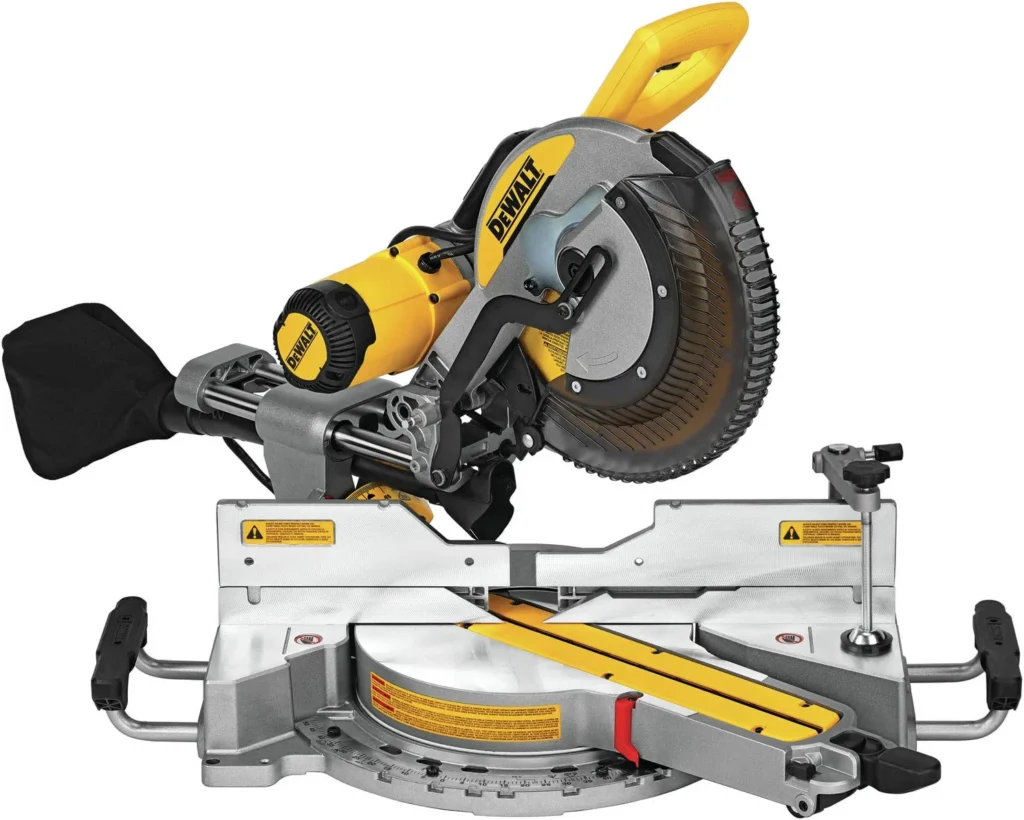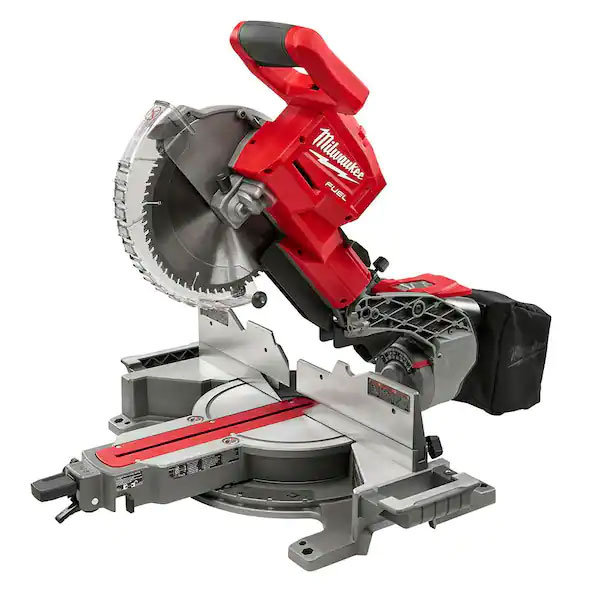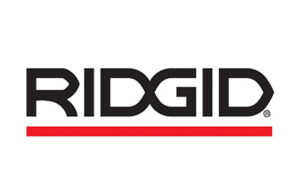Miter Saws for any
Precision job
From Affordable to Professional–Grade: Be Covered by Our Catalogue, Guides, and More.
2023 mitre saw Guide
Get the Most Out: Features, Advantages, and Prices.
Learn more
Sliding Compound
Cordless
12 Inch Blade
10 Inch
overview
best offers 2023
-
For beginners:
DEWALT, 12-Inch, Double Bevel, Compound, XPS Cutline, 15-Amp (DWS716XPS) -
For the Budget:
RIDGID 15 Amp 10 in. Dual with LED Cut Line Indicator -
Best Sliding Compound:
DEWALT Sliding Compound, 12-Inch (DWS779) -
Best Cordless (Portable):
Milwaukee 2734-21HD M18 Fuel, Dual Bevel, Sliding Compound 10" -
For metal cutting:
Milwaukee 6955-20 12" Dual Bevel Sliding Compound -
For woodworking:
Bosch GCM12SD 15 Amp 12 Inch Corded Dual-Bevel Sliding Glide -
Most accurate:
Milwaukee 2734-20 M18 Fuel, 10", Dual Bevel, Sliding Compound -
best 10 inch miter saw:
Makita LS1019L 10" Dual-Bevel Sliding Compound with Laser -
Best 12 inch Miter Saw:
RIDGID 15 Amp Corded 12 in. Dual Bevel Sliding with LED -
Best small (compact) miter saw:
Metabo HPT 10-Inch Single Bevel Compound 15-Amp, C10FCGS
People Also Asked
Is it worth buying a miter saw?
Whether or not is it worth buying depends on your cutting needs, frequency of use, available space, and budget. If you regularly need to make precise angled cuts and have the space and budget, a miter saw can be a valuable investment.
Make an informed decision based on the needs and demands of your project.
What is a miter saw good for?
It is a specialized saw, designed to make precise angled cuts, such as those needed for framing, molding, and other woodworking projects. Miter saws are ideal for making clean and accurate crosscuts, miter and bevel or angled cuts.
What should you not cut with it?
A miter saw is designed to cut wood and other soft materials, but it can also easily cut through light metals like aluminum and steel. However, it is important to ensure that you have the right blade for the job in order to get the best results, avoid potential damage to the saw, prevent potential injury to the user, and ensure precise cuts.
To ensure success when cutting metal, be sure to purchase a blade that is specifically designed for this purpose. Pay also attention to its RPM rating, and make sure that it matches the maximum speed of your saw.
This will ensure that the blade is capable of withstanding the demands of cutting through metal. Using a blade with a lower RPM rating than your saw can result in poor performance, while using a blade with a higher RPM rating can be dangerous and potentially cause serious injury.
By selecting the right blade for your miter saw, you can achieve precise, clean cuts in a variety of materials, including metal.
Can you use any blade?
No, you cannot put any blade on a mitre saw. The type of blade you can use on a miter saw depends on the saw’s specifications and the type of material you want to cut. Miter saw blades come in different sizes, materials, and tooth configurations, each designed for specific applications. For example, a blade designed for cutting wood may not be suitable for cutting metal or tile.
When selecting a blade for your miter saw, you need to consider the diameter of the blade, the number and shape of the teeth, and the arbor size. The blade diameter should match the saw’s specifications, while the number and shape of the teeth will determine the type of cut you can make. The arbor size of the blade must also match the arbor size of the saw.
It’s essential to use the correct blade for the material you are cutting and to ensure that the blade is compatible with your miter saw to avoid damage to the saw or the blade, as well as potential safety hazards. Always refer to the manufacturer’s instructions or consult with a professional to determine the appropriate blade for your miter saw and cutting needs.
Miter saw vs. Table saw
A miter saw and a table saw are both valuable tools for woodworking, but they serve different purposes.
A miter saw is designed for making angled cuts, particularly crosscuts and miter cuts. It uses a circular blade mounted on a swiveling arm to cut wood at various angles, making it ideal for tasks such as cutting crown molding, trim, and framing lumber. A miter saw is great for making quick, accurate cuts in wood at various angles, and it’s a popular choice for many woodworkers and DIY enthusiasts.
On the other hand, a table saw is designed for making straight cuts and ripping lumber. It consists of a circular blade mounted on an arbor, which protrudes through a flat surface. The wood is pushed along the surface of the saw, against the blade, to make the cut.
Both tools have their advantages, and the choice between them ultimately depends on the specific needs of the project at hand.
Miter saw vs. Chop saw
Miter saws and chop saws are both types of power saws, but they are designed for different cutting applications.
A chop saw, is designed for cutting through tough materials such as metal, masonry, and other hard materials. It uses a powerful motor to spin an abrasive or carbide blade at high speeds to make clean, accurate cuts. Chop saws are commonly used in construction, metal fabrication, and welding applications.
While both tools use a circular blade, a miter saw is designed for making angled cuts in wood, while a chop saw is designed for cutting through tough materials like metal and masonry. It’s important to use the appropriate saw for the material being cut to ensure safety and accuracy.
Miter saw vs. Circular saw
Is a miter saw better than a circular saw? Do I need a circular saw if I have a miter saw? Can a miter saw do everything a circular saw can?
These are common questions that people ask when deciding between a miter saw and a circular saw. While both tools are useful for cutting different materials, each has its unique features that set them apart.
While a miter saw has a stationary base, arm, and a vertical saw blade that requires a stable surface to work on, a circular saw is a portable tool that heavily relies on the user’s skill for precision. This means that a miter saw is better suited for making precise angle cuts and can cut through thicker materials. On the other hand, a circular saw is more versatile and portable, making it ideal for cutting large sheets of material that are too big to fit on a miter saw.
Similarly, the circular saw blade is circular, and it can cut through a variety of materials such as plastic, metal, or wood, but due to its handheld nature, it may not be as accurate as a miter saw.
Ultimate Guide
miter saw parts
- Base: Supports and stabilizes the workpiece during cutting.
- Fence: The fence is a vertical guide that keeps the material being cut at the correct angle and provides support.
- Blade: The blade is the cutting component of the saw, which can be adjusted for both angle and depth.
- Arm: The arm is the part of the saw that connects the base to the blade, allowing the blade to pivot and make angled cuts.
- Miter scale: The miter scale is a gauge that displays the angle at which the blade is set to cut.
- Bevel adjustment: The bevel adjustment allows the user to tilt the blade to make bevel cuts.
- Stand: Flat surface where the tool is placed and supported during the cutting process. The miter saw on table configuration ensures stability and accuracy during cutting operations.
- Dust bag or collection system: A dust bag or collection system is used to collect sawdust and debris during cutting, reducing mess and promoting safety.
- Safety features: Miter saws often have safety features such as blade guards, trigger locks, and electric brakes to help prevent accidents.
In addition to these parts, some miter saws may also include:
- Clamp: which helps to secure the material being cut in place.
- Laser guide: which projects a laser line onto the material being cut to help the user align the blade more accurately
- Battery: for cordless operation.
Additionally, some miter saws may come with a stand, station, or workbench, which provides a stable and safe surface for the saw to be used on.
Types
Standard
The most basic form of a miter saw, which is sometimes mistakenly referred to as a “chop saw,” operates by pivoting the swing arm to the desired angle before cutting through the material. These straightforward power saws are limited to creating miter cuts, which explains their lesser popularity compared to other saw varieties.
Single bevel compound
Aside from creating angled cuts, a single bevel compound is capable of tilting its swing arm to one side (usually the left) to generate a beveled and mitered cut. This function proves useful for projects such as crown molding installation or specific roof rafter cuts.
Example Model:
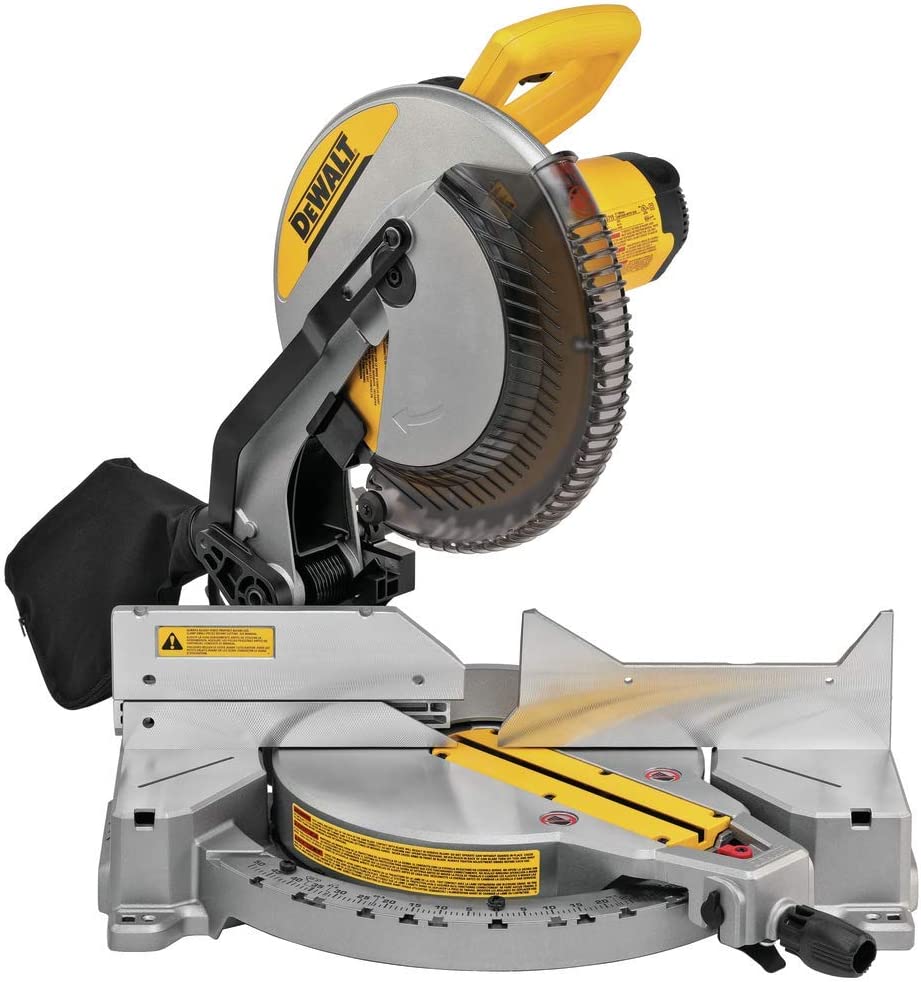
Tall sliding fences support 5-1/2-inch of base molding vertically and 5-1/2-inch of crown molding vertically nested.
Item Weight: 42.8 pounds
Speed: 4500 RPM
Dual-Bevel Compound
Similar to a single bevel, a dual bevel compound is capable of producing bevels. However, unlike the single bevel saw, the swing arm of a dual bevel compound can tilt in both directions. Although a single compound miter saw can execute the same cuts, it would require the user to flip the board to cut a bevel in the opposite direction, whereas a dual bevel saw can save time by eliminating that step. In essence, the dual bevel function offers a convenience and saves time.
Example Model:
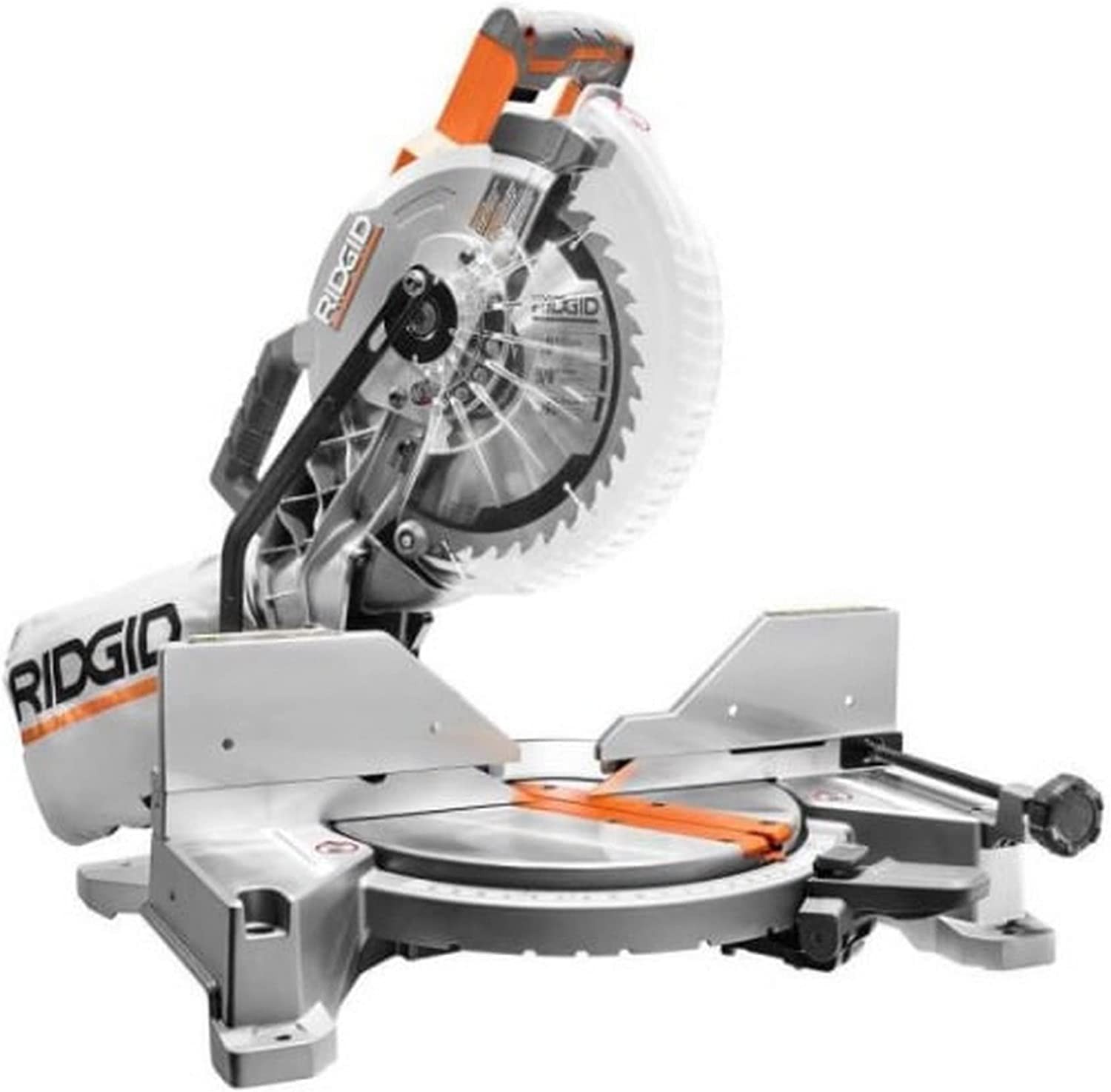
Cut at 0° to 48° both left and right, with crown molding stops for convenient material handling.
Speed: 5000 RPM
Compound sliding
Basically a miter saw with slide, compound miter saws are equipped with sliding rails enable the user to cut wider boards. Mitre saws lacking sliding capabilities have a maximum cutting width slightly smaller than their blade diameter, with a 10-inch blade capable of cutting a board up to 6 inches wide. When cutting a broader board, it’s necessary to flip it over to finish the cut.
A sliding compound is the best option when it comes to cutting wide boards, since the user can pull the saw’s motorhead towards themselves, lower it, engage the motor, and push it through the board. Depending on the model, a sliding miter saw can handle board widths ranging from 10 to 18 inches and can be either a single or dual bevel compound. High-quality compound miter saws may also have zero-clearance arms that allow them to sit close to a wall without hindering the blade’s movement.
Cordless
Recently, cordless miter saws have emerged as a fresh option, using rechargeable lithium-ion batteries to operate. These saws, powered by batteries, are ideal for individuals seeking portability and mobility while still capable of executing demanding cutting tasks. The battery’s runtime will vary depending on the number of cuts and the wood’s thickness, with an average of approximately 150 to 275 cuts per single battery charge.
Safety Recommendations
When using a miter saw, take safety precautions. Wear eye and ear protection, keep hands away from the blade, make sure the saw is securely attached to a sturdy table, or miter saw station, and ensure the saw has a legitimate safety guard with an efficient dust collection system. Additionally, be aware of your surroundings and always unplug the tool when not in use or when replacing the blade.
What is the biggest hazard?
The biggest hazard when using this powerful tool is the risk of injury from the blade, which is extremely sharp and can cause serious injury if it comes into contact with the user’s body, including fingers, hands, and arms. In addition, the saw can generate a lot of sawdust and debris, which can cause eye or lung irritation if proper protective equipment is not used. Therefore, it is important to follow all safety guidelines, including wearing appropriate personal protective equipment and using the saw in a well-ventilated area.
How often do you need to change the blade?
The frequency with which you need to change the blade of a miter saw depends on several factors, such as how often you use the saw, what type of material you cut, and the condition of the blade. A dull blade will produce poor-quality cuts and may even damage the material or the saw itself.
As a general rule, you should replace the blade when it starts to show signs of wear, such as dullness or chipping. Additionally, if you notice that the blade is producing a lot of sparks, smoking, or making unusual noises, it may be time to replace it.
In summary, you should change it when it starts to affect the quality of your cuts or when it shows signs of wear and tear. It is also essential to follow the manufacturer’s instructions for blade replacement and maintenance to ensure safe and effective operation of the saw.
